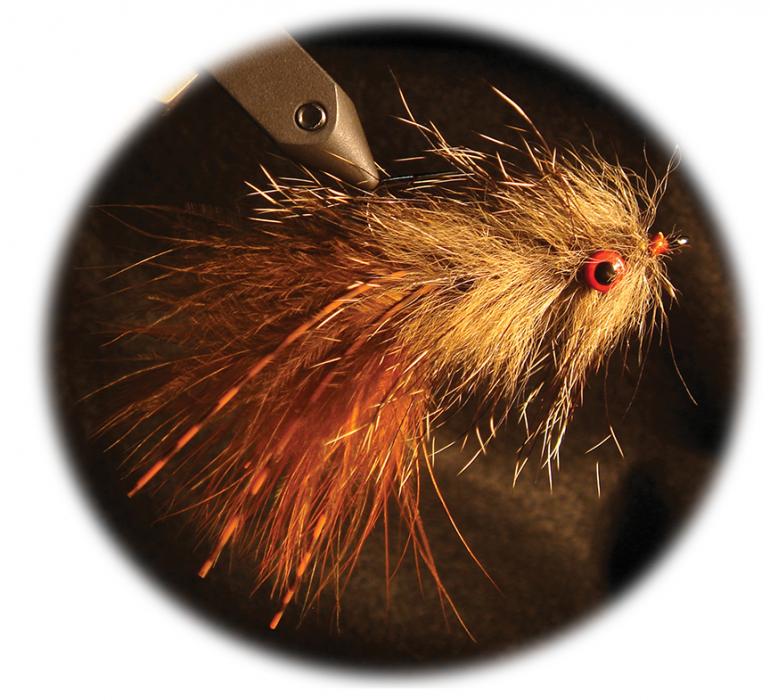Big & Nasty
Tying and fishing the Sasquatch.
The cooler and shorter days of fall unleash some epic days on rivers all over Montana. Brown trout are fall spawners, and they tend to get rather aggressive toward smaller fish and anything else that gets in their way. They know that winter is right around the corner, and it is time to put some weight on before the big chill.
For those of you who like to fish big streamers for large trout, the Sasquatch fully embodies the term “big and nasty.” Although not for everyone, fishing large streamers is consistently one of the most reliable flies to attract big trout. Once trout get up to the 14- to 16-inch range, especially brown trout, they start to pay attention to bigger meals such as sculpins and crayfish. This impressionistic streamer pattern does not look exactly like a crayfish or a sculpin to you and me, but in the water it really comes alive with a ton of movement.
Another valuable quality of this pattern is the amount of water it pushes. All fish, including trout, have a chain of very sensitive nerves that run along their lateral line. These nerves sense the vibrations of their prey swimming along. They can literally feel what is around them. The spun-fur body on the Sasquatch, made entirely out of coarse woodchuck hair, pushes a huge amount of water and really gets a trout’s attention.
Woodchuck hair has been a useful, but uncommon fly-tying material for a long time. The hair is naturally mottled just like crayfish and sculpins. It also soaks up water very quickly, allowing you to get this fly down deep quickly. It is tough as nails; you will lose this fly long before it wears out.
I like to fish the Sasquatch on heavy tippet, usually 0X. Not only does this give you stopping power for a giant fish that wants to take you into the logjam, if you get snagged (which you certainly will if you are fishing streamers the right way), you stand a much better chance at getting your fly back with the heavy tippet.
Rivers like the Yellowstone, Madison, and Missouri are great places to fish this fly. My favorite method is slapping this fly into a bank with a good fish-holding structure, out of a drift boat with a skilled guy on the oars. Let the fly sink in the deeper spots; use a sink-tip line if you really want to get this fly down. An erratic stop-and-go retrieve usually works the best for me. Sometimes dead-drifting this fly can be very effective as well. You will know it when a fish hits a streamer of this size—most of the time the strikes are bone-jarring. Don’t expect to catch a ton of fish on this pattern; hell, this fly will scare your average fish! If you do get one to eat this fly, chances are that it might be one of the biggest of your season.
Materials
Hook: Tiemco 777 #2
Thread: UTC 140, Burnt Orange
Eyes: Painted dumbbell eyes, medium-size
Tail: Burnt orange & brown marabou, speckled brown rubber legs
Body: Woodchuck hair spun in between a loop of medium-gauge Ultra Wire
Instructions
1. Tie in 2-3 plumes of marabou and rubber legs for the tail and attach lead dumbbell eyes up near the eye of the hook as shown.
2. Tie in a 5-inch loop of medium gauge Ultra Wire at the tail; apply some sticky dubbing wax to the wire to help keep the hair in the loop. Lay a big bunch of woodchuck hair inside the wire loop and spread it evenly up and down the wire loop.
3. Once you get the hair evenly spaced throughout the loop, take a dubbing hook and twist the wire loop until the fur is spun tight enough that you cannot pull the hair out easily. Then wrap the woodchuck fur ”brush” up the shank of the hook up to the eye and tie off. Apply some head cement and make it live dangerously on the river!
Doug Mcknight is a fly-tying and fishing fanatic who works at Yellow Dog Flyfishing Adventures.












